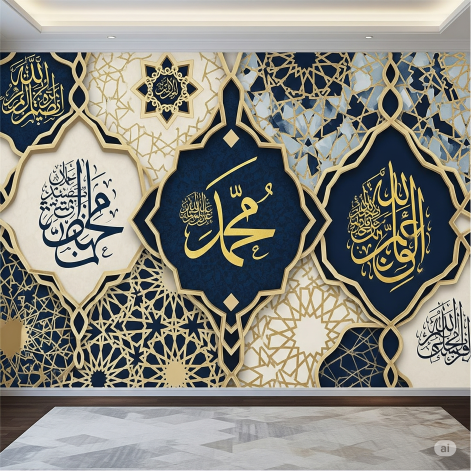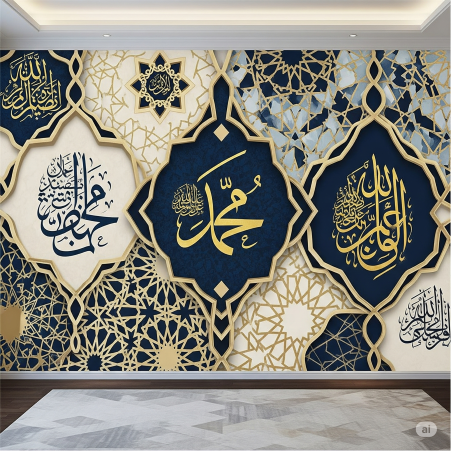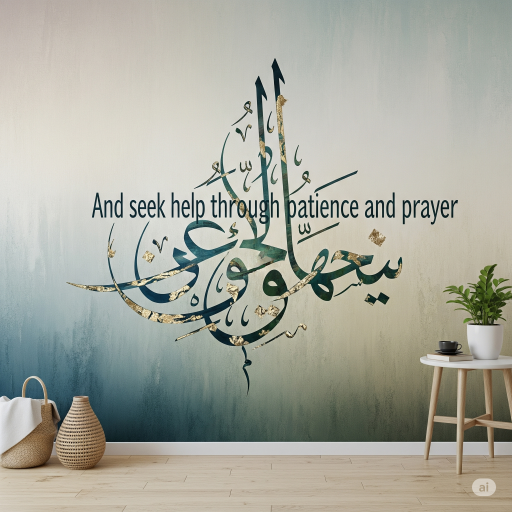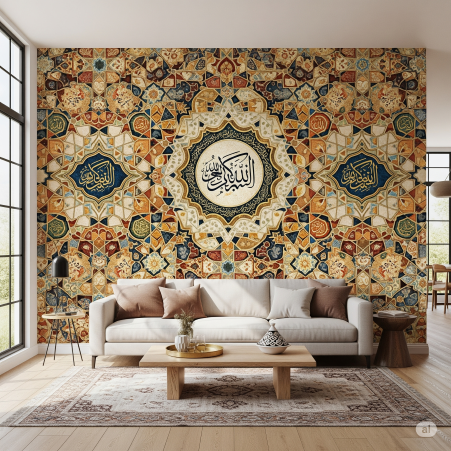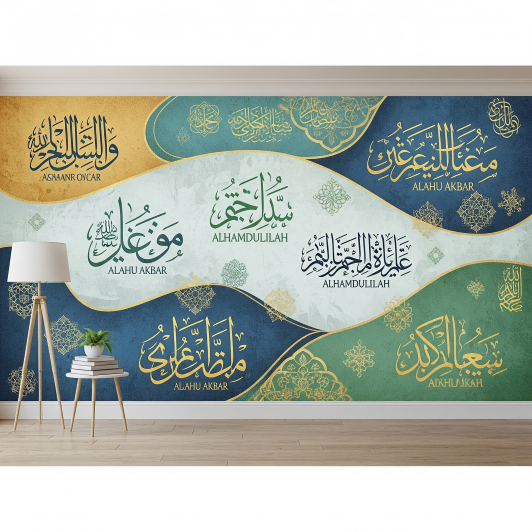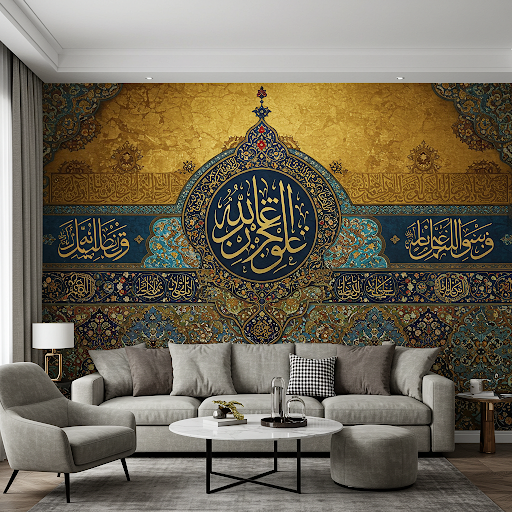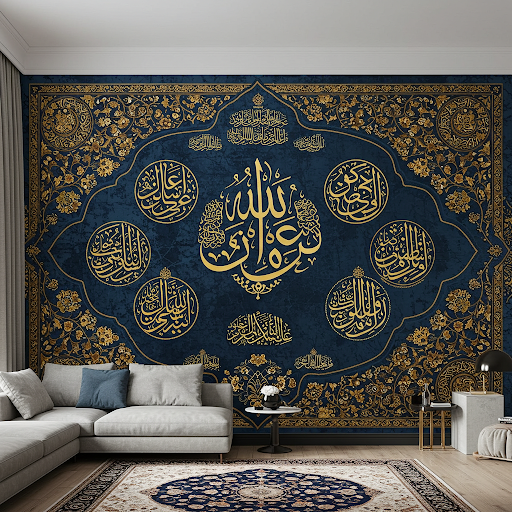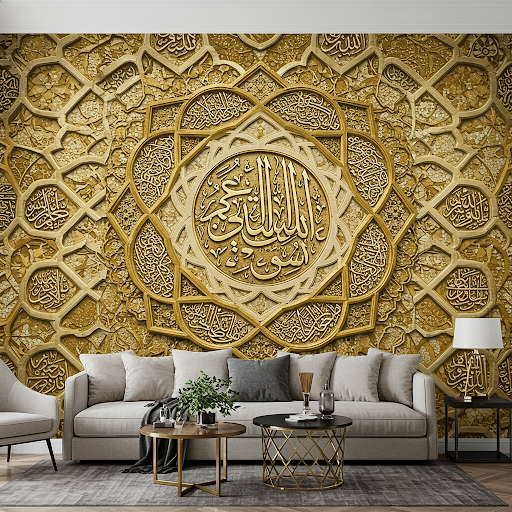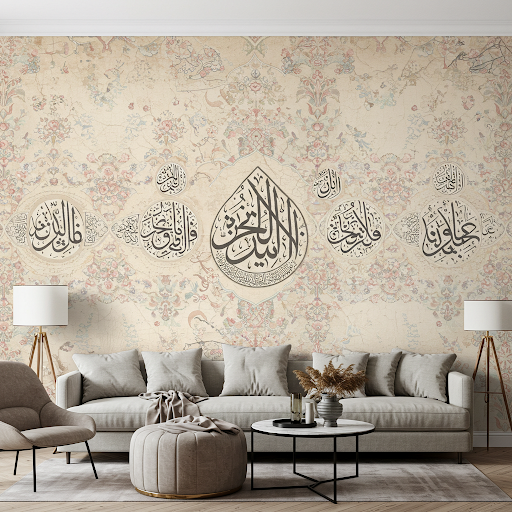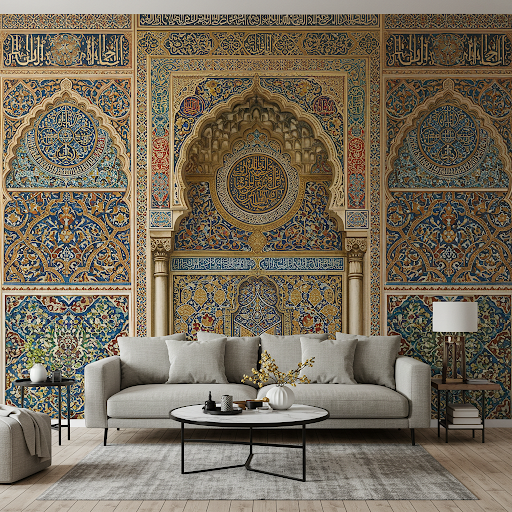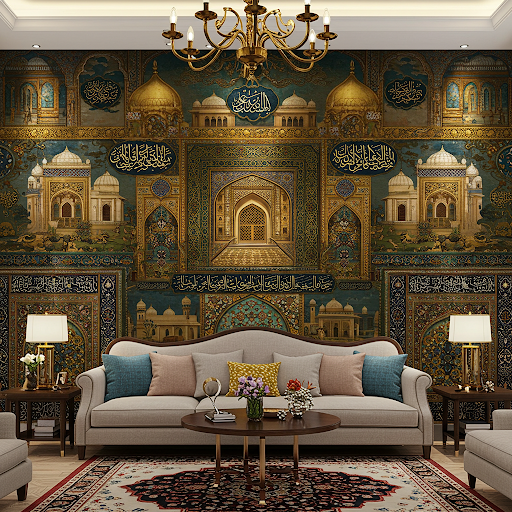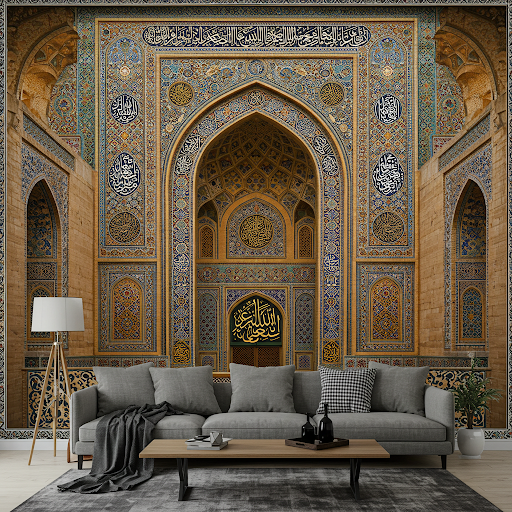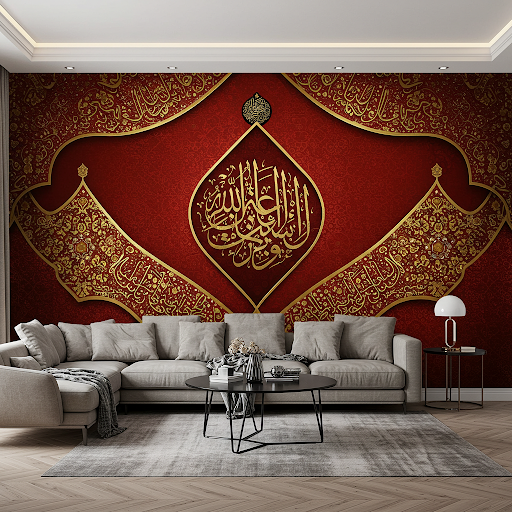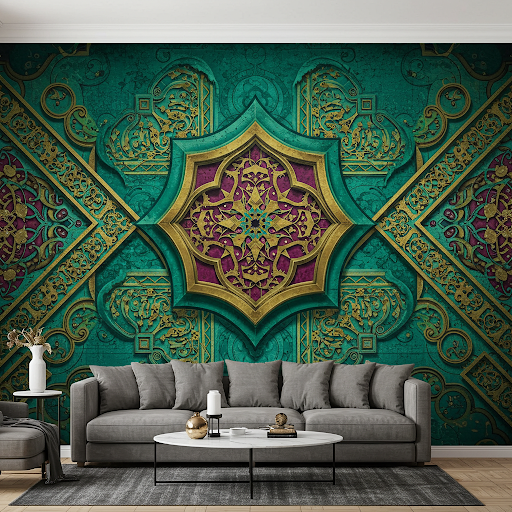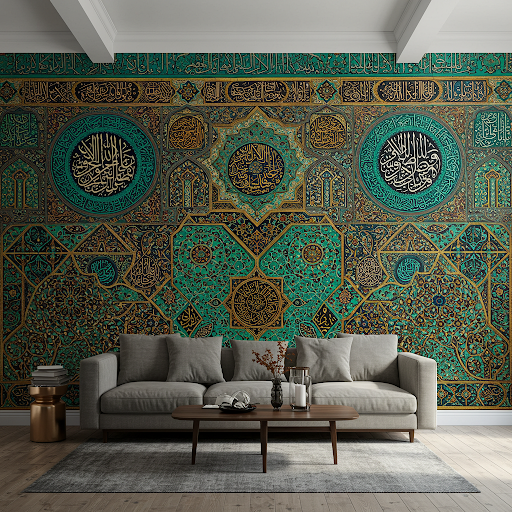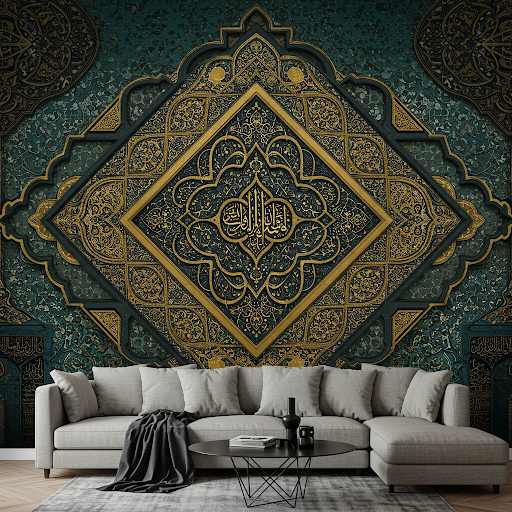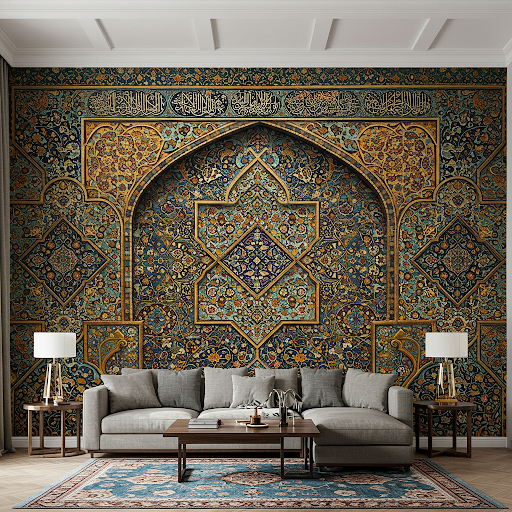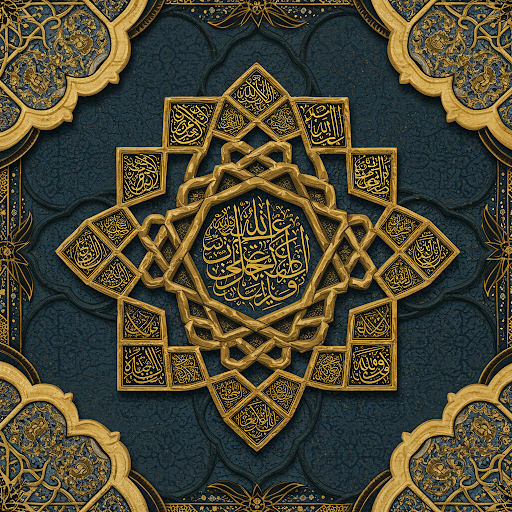Description
Arabesque pattern wallpaper: Key Design Principles
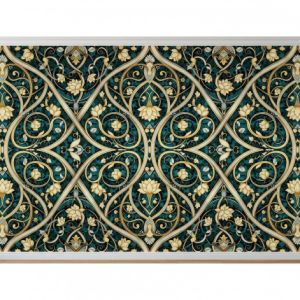
An Arabesque pattern wallpaper is a type of decorative wall covering featuring intricate, repeating geometric, floral, and vegetal motifs. It is a defining element of Islamic art. And is distinguished by its non-figurative and rhythmic designs that interlock and intertwine across a surface. The term “Arabesque” is derived from the Italian word “arabesco,” meaning “in the Arab style.” And it reflects the pattern’s origins in the Islamic world.
Geometric Repetition Wallpaper
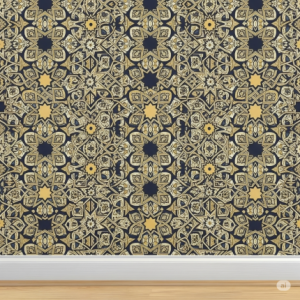
The principle of geometric repetition is central to Arabesque Wallpaper. Transforming simple shapes into a profound statement of harmony and order. This is a deliberate choice, not just an aesthetic one. The patterns are meticulously constructed using complex mathematical formulas. And employing principles like tessellation and radial symmetry to ensure every line, star, and polygon interlocks perfectly. This mathematical precision gives the designs their continuous, non-ending flow, which is a powerful visual metaphor.

This uninterrupted repetition symbolizes the limitless and indivisible nature of the Divine. Reflecting a worldview where the cosmos is an endless, interconnected tapestry. By avoiding a central focal point, the pattern encourages the viewer’s eye to wander across the entire surface, subtly shifting focus from a single object to the unified whole. This creates a sense of balance and intellectual elegance, turning a static wall into a dynamic yet calming backdrop. In contemporary wallpaper, this ancient principle provides a timeless and sophisticated way to bring spiritual and mathematical order into modern interior design.
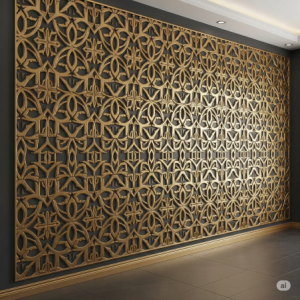
Vegetal Motifs Wallpaper
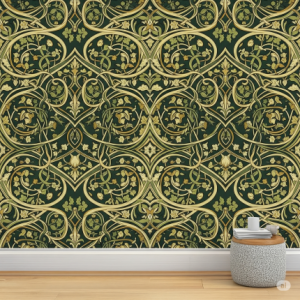
Vegetal motifs are a defining feature of Arabesque patterns, providing an essential fluid and organic counterpoint to the rigid geometric foundations. These designs are characterized by stylized, curved forms of leaves, vines, and floral elements that flow seamlessly and endlessly into one another, creating a visually cohesive and harmonious mural.
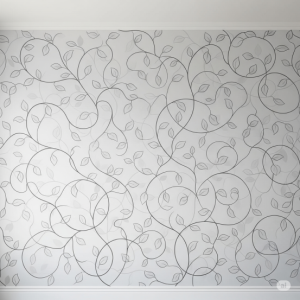
The beauty of these motifs lies in their abstraction. They are not realistic representations but rather symbolic forms. This deliberate abstraction is in line with the non-figurative principles of Islamic art. And which discourages the depiction of living beings. Instead, the swirling vines and intertwined leaves represent the concepts of life, growth, and the natural world as manifestations of divine creation. This endless, flowing quality also symbolizes the limitless mercy and grace of God.
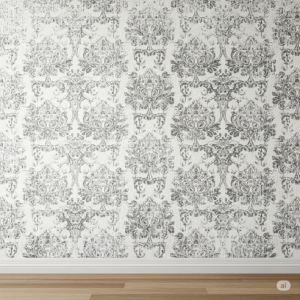
As a wallpaper mural, this style creates a feeling of gentle movement and organic rhythm. Transforming a static wall into a living tapestry of interwoven patterns. The graceful lines and fluid forms bring the beauty of nature indoors in a sophisticated, symbolic way. Infusing a space with a serene and elegant ambiance. In modern contexts, these motifs are often rendered in sophisticated color palettes. From traditional blues and golds to minimalist black and white. Making them a versatile choice for both classic and contemporary interiors.
Non-Figurative Arabesque Patterns Wallpaper

The non-figurative nature of Arabesque patterns is a deliberate artistic choice rooted in the Islamic principle of aniconism, which discourages the depiction of sentient beings to prevent idolatry. This principle elevates the art from mere decoration to a powerful tool for spiritual contemplation.
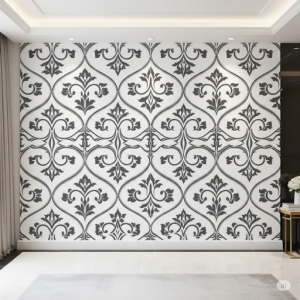
Symbolic Transcendence
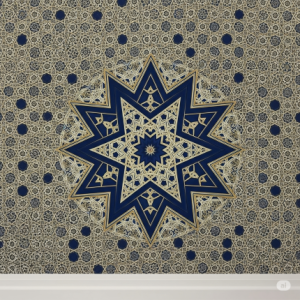
By focusing on abstract forms, Arabesque patterns guide the viewer to look beyond the material world. The intricate, interlocking designs without a central focal point symbolize the infinite and boundless nature of God. Unlike a painting of a person or a scene, which has a defined beginning and end, the repeating patterns suggest a universe of continuous order and harmony. A visual metaphor for the divine presence that is everywhere and without limits. This encourages a meditative state, guiding the mind toward reflection and away from worldly distractions.
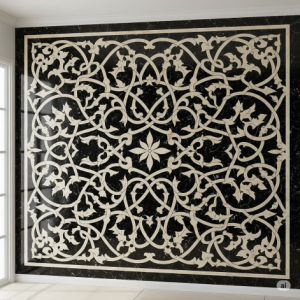
Creating a Serene Atmosphere
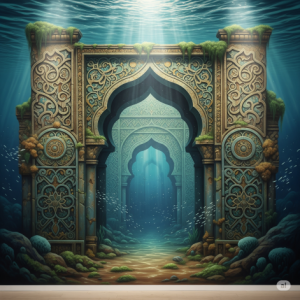
As a wallpaper mural, this style transforms a room into a tranquil and thought-provoking sanctuary. The lack of a distracting narrative or figure allows the mind to find peace and focus on the overall harmony of the design. The subtle expression of faith and beauty through these patterns makes a space feel both sophisticated and spiritually grounded. Arabesque patterns wallpaper art creates an environment that promotes a sense of calm. And encourages a deep connection to a higher, universal order.

Arabesque Pattern Wallpaper Symmetry and Rhythm
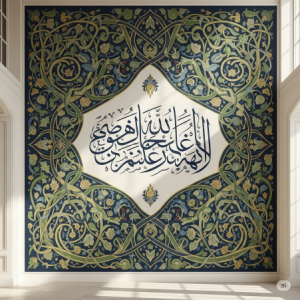
The mesmerizing appeal of Arabesque patterns is rooted in their meticulous balance, achieved through a strict adherence to symmetry, tessellation, and a rhythmic flow. Every element is precisely calculated to fit together seamlessly, creating a design that can be endlessly repeated without a break. This use of tessellation, where shapes interlock perfectly to fill a space, gives the patterns a sense of infinite continuity. This geometric harmony is not just for visual pleasure; it symbolizes the perfect order and balance of the universe, reflecting a deep spiritual understanding. As a wallpaper mural, the combination of repetition and intricate detail is visually captivating, drawing the eye into a complex yet serene world. It transforms a wall into a dynamic yet orderly masterpiece, conveying a sense of stability and endless beauty.
Arabesque Pattern Wallpaper Symbolism and Meaning
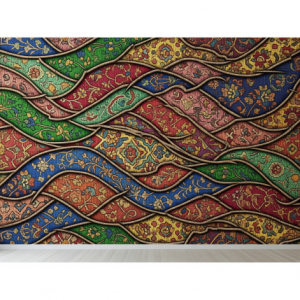
The Arabesque pattern wallpaper is not just for decoration. It carries deep spiritual significance. The designs are a visual representation of the Islamic worldview, where the repeating, endless patterns symbolize the infinite and indivisible nature of God. The fluid, non-ending lines of the arabesque also represent the interconnectedness of all creation. And the spiritual journey of life. This is achieved by creating intricate, interlocking designs that suggest a universe of continuous order and harmony. The deliberate avoidance of a central focus in the pattern encourages the viewer to look at the design as a whole. Contemplating the vast and eternal nature of the divine, as opposed to a single, limited point of reference.
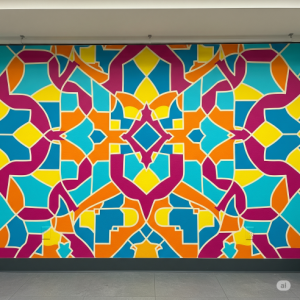
Gold arabesque wallpaper
The use of gold is central to this style. The gold can be a lustrous, metallic sheen or a more muted, textured watercolor look. The gold tones add warmth, richness, and a sense of opulence to any space.
While the style is traditional, gold arabesque murals can be a great fit for a variety of decor styles. They can create a dramatic, luxurious feel in a formal dining room or living area, or add a touch of sophistication to a modern, minimalist space.
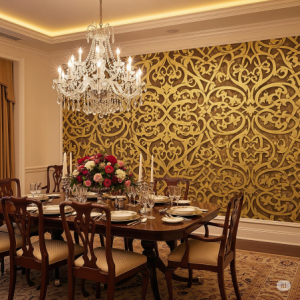
Modern Applications Today

Today, Arabesque pattern wallpaper has beautifully transitioned from its historical context to become a powerful element in contemporary interior design. This evolution is a testament to the pattern’s timeless appeal and versatility.
The Modern Makeover
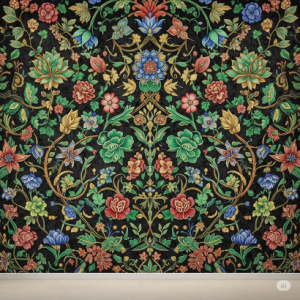
Modern interpretations of Arabesque wallpaper have shed some of their traditional, ornate characteristics to fit a more minimalist and clean aesthetic. While classic designs favored rich golds, deep blues, and vibrant reds, today’s palettes have expanded to include subtle grays, soft pastels, and stark black-and-white combinations. This allows the intricate patterns to stand out without overwhelming a modern space. Additionally, designers are experimenting with new textures and materials, such as metallic or embossed finishes, to give the ancient art form a fresh, tactile dimension.
Versatile Use in Modern Spaces
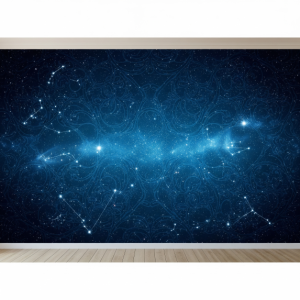
The beauty of Arabesque wallpaper lies in its ability to bring a sense of history, sophistication, and cultural richness to a variety of settings.
Residential Homes
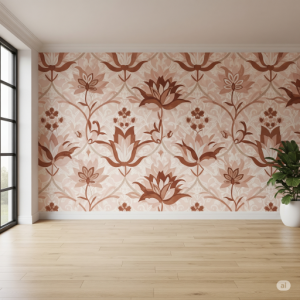
In living rooms, it’s often used on a feature wall to create a stunning focal point, blending elegance with an exotic flair. In bedrooms, a subtle Arabesque pattern behind the headboard can create a serene and luxurious sanctuary.
Arabesque pattern nursery wallpaper
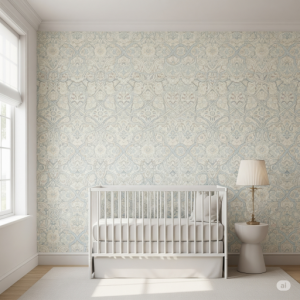
An Arabesque pattern nursery wallpaper mural is a unique and thoughtful choice that goes far beyond traditional nursery themes. It transforms the space into a serene, elegant, and timeless environment, offering both a beautiful aesthetic and a deeper, symbolic meaning.
Perfected for the Nursery Palette
The key to adapting this traditional art form for a nursery is in the color palette. Instead of the rich, deep colors of historical Arabesque art, modern nursery murals employ soft, muted tones, such as pastel pinks, light blues, light grays, and serene beiges. A monochromatic approach, where a light gray pattern is placed on an off-white background, creates a sophisticated and minimalist look. Alternatively, a mural with a subtle metallic or pearlescent sheen can add a touch of magic and luxury without being overpowering.
Symbolism for a New Life
Beyond aesthetics, the Arabesque mural carries profound symbolism perfectly suited for a new life. The infinite, interconnected patterns can symbolize endless love, the unity of family, and the spiritual journey of life. The fluid, non-figurative lines encourage a child’s imagination to wander, while providing a soothing, organized backdrop for their development. This type of mural creates a sanctuary of peace and love, enriching the space with both a sense of beauty and a meaningful, subtle expression of faith and heritage.
Commercial Spaces
Architects and designers frequently incorporate these patterns in commercial settings to build a unique brand identity. In luxury hotels and restaurants, a large-scale Arabesque mural can evoke a sense of grandeur and cultural heritage. While in high-end retail stores or office reception areas, it can add a touch of sophisticated flair that is both welcoming and visually striking. The wallpaper effectively blends a timeless art form with contemporary decor. It provides a sense of depth and elegance that simple geometric or abstract patterns often lack.

